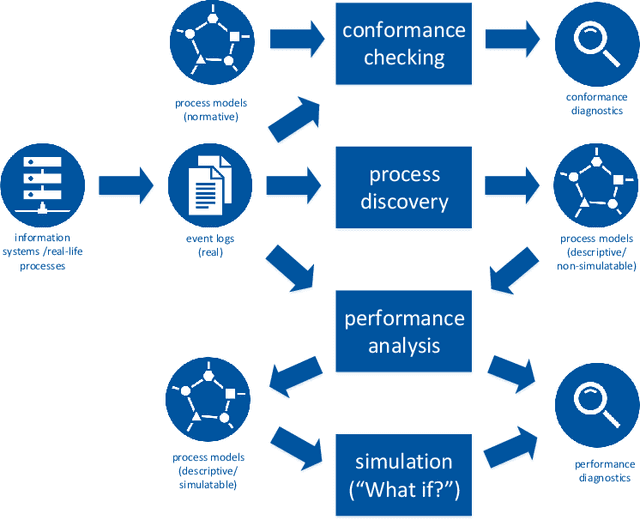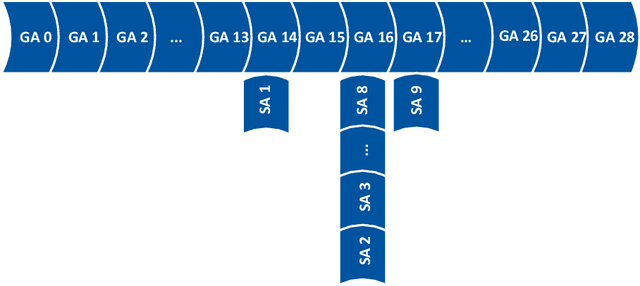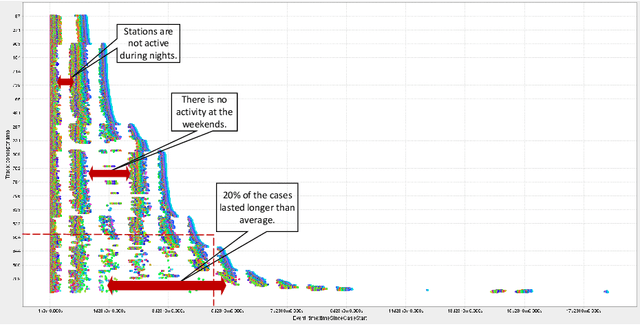Merih Seran Uysal
Resolving Uncertain Case Identifiers in Interaction Logs: A User Study
Nov 21, 2022Abstract:Modern software systems are able to record vast amounts of user actions, stored for later analysis. One of the main types of such user interaction data is click data: the digital trace of the actions of a user through the graphical elements of an application, website or software. While readily available, click data is often missing a case notion: an attribute linking events from user interactions to a specific process instance in the software. In this paper, we propose a neural network-based technique to determine a case notion for click data, thus enabling process mining and other process analysis techniques on user interaction data. We describe our method, show its scalability to datasets of large dimensions, and we validate its efficacy through a user study based on the segmented event log resulting from interaction data of a mobility sharing company. Interviews with domain experts in the company demonstrate that the case notion obtained by our method can lead to actionable process insights.
Uncertain Case Identifiers in Process Mining: A User Study of the Event-Case Correlation Problem on Click Data
Apr 08, 2022



Abstract:Among the many sources of event data available today, a prominent one is user interaction data. User activity may be recorded during the use of an application or website, resulting in a type of user interaction data often called click data. An obstacle to the analysis of click data using process mining is the lack of a case identifier in the data. In this paper, we show a case and user study for event-case correlation on click data, in the context of user interaction events from a mobility sharing company. To reconstruct the case notion of the process, we apply a novel method to aggregate user interaction data in separate user sessions-interpreted as cases-based on neural networks. To validate our findings, we qualitatively discuss the impact of process mining analyses on the resulting well-formed event log through interviews with process experts.
Probability Estimation of Uncertain Process Trace Realizations
Aug 20, 2021



Abstract:Process mining is a scientific discipline that analyzes event data, often collected in databases called event logs. Recently, uncertain event logs have become of interest, which contain non-deterministic and stochastic event attributes that may represent many possible real-life scenarios. In this paper, we present a method to reliably estimate the probability of each of such scenarios, allowing their analysis. Experiments show that the probabilities calculated with our method closely match the true chances of occurrence of specific outcomes, enabling more trustworthy analyses on uncertain data.
Removing Operational Friction Using Process Mining: Challenges Provided by the Internet of Production (IoP)
Jul 27, 2021



Abstract:Operational processes in production, logistics, material handling, maintenance, etc., are supported by cyber-physical systems combining hardware and software components. As a result, the digital and the physical world are closely aligned, and it is possible to track operational processes in detail (e.g., using sensors). The abundance of event data generated by today's operational processes provides opportunities and challenges for process mining techniques supporting process discovery, performance analysis, and conformance checking. Using existing process mining tools, it is already possible to automatically discover process models and uncover performance and compliance problems. In the DFG-funded Cluster of Excellence "Internet of Production" (IoP), process mining is used to create "digital shadows" to improve a wide variety of operational processes. However, operational processes are dynamic, distributed, and complex. Driven by the challenges identified in the IoP cluster, we work on novel techniques for comparative process mining (comparing process variants for different products at different locations at different times), object-centric process mining (to handle processes involving different types of objects that interact), and forward-looking process mining (to explore "What if?" questions). By addressing these challenges, we aim to develop valuable "digital shadows" that can be used to remove operational friction.
Text-Aware Predictive Monitoring of Business Processes
Apr 21, 2021



Abstract:The real-time prediction of business processes using historical event data is an important capability of modern business process monitoring systems. Existing process prediction methods are able to also exploit the data perspective of recorded events, in addition to the control-flow perspective. However, while well-structured numerical or categorical attributes are considered in many prediction techniques, almost no technique is able to utilize text documents written in natural language, which can hold information critical to the prediction task. In this paper, we illustrate the design, implementation, and evaluation of a novel text-aware process prediction model based on Long Short-Term Memory (LSTM) neural networks and natural language models. The proposed model can take categorical, numerical and textual attributes in event data into account to predict the activity and timestamp of the next event, the outcome, and the cycle time of a running process instance. Experiments show that the text-aware model is able to outperform state-of-the-art process prediction methods on simulated and real-world event logs containing textual data.
PROVED: A Tool for Graph Representation and Analysis of Uncertain Event Data
Mar 09, 2021



Abstract:The discipline of process mining aims to study processes in a data-driven manner by analyzing historical process executions, often employing Petri nets. Event data, extracted from information systems (e.g. SAP), serve as the starting point for process mining. Recently, novel types of event data have gathered interest among the process mining community, including uncertain event data. Uncertain events, process traces and logs contain attributes that are characterized by quantified imprecisions, e.g., a set of possible attribute values. The PROVED tool helps to explore, navigate and analyze such uncertain event data by abstracting the uncertain information using behavior graphs and nets, which have Petri nets semantics. Based on these constructs, the tool enables discovery and conformance checking.
Conformance Checking over Uncertain Event Data
Sep 29, 2020



Abstract:Nowadays, more and more process data are automatically recorded by information systems, and made available in the form of event logs. Process mining techniques enable process-centric analysis of data, including automatically discovering process models and checking if event data conform to a certain model. In this paper, we analyze the previously unexplored setting of uncertain event logs: logs where quantified uncertainty is recorded together with the corresponding data. We define a taxonomy of uncertain event logs and models, and we examine the challenges that uncertainty poses on process discovery and conformance checking. Finally, we show how upper and lower bounds for conformance can be obtained aligning an uncertain trace onto a regular process model.
 Add to Chrome
Add to Chrome Add to Firefox
Add to Firefox Add to Edge
Add to Edge